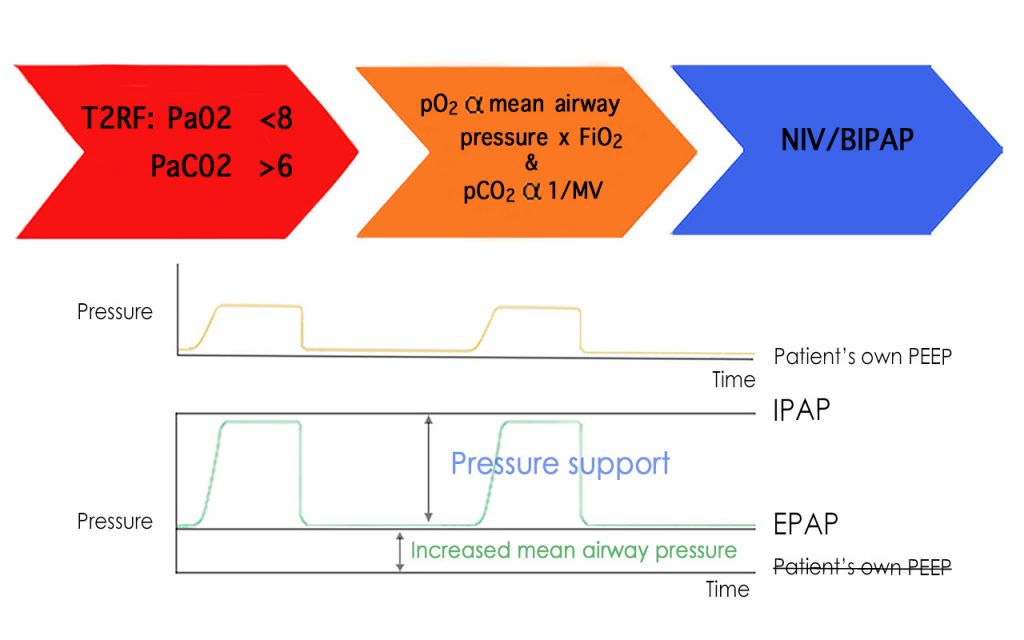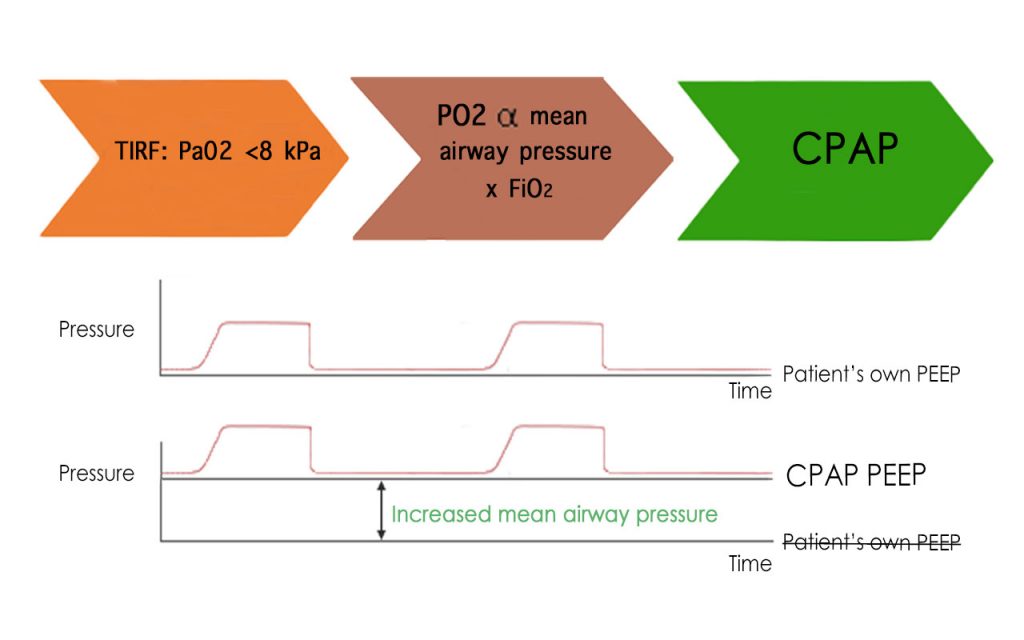Contra-indications to NIV
- Life threatening hypoxia
- Unconscious or low GCS (<8)
- Inability to protect the airway
- Un-drained pneumothorax
- Fixed obstruction of the upper airway
- Facial trauma or recent surgery
- Vomiting
- Non-compliant patient
Advantages of NIV in COVID
Pressure Support (PS)/Inspiratory Positive Airway Pressure* (IPAP*)
- Supports inspiration
- Increases tidal volume
- Improves recruitment and compliance
- Reduces work of breathing
Positive End Expiratory Pressure (PEEP)/Expiratory Positive Airway Pressure* (EPAP*)
- Positive end expiratory pressure throughout the ventilatory cycle
- Improves alveolar recruitment
- Increases mean airway pressure
- Improves recruitment and reduces shunt
- Unloads respiratory muscles and reduces the work of breathing
*In BiPAP mode.
Type 2 Respiratory Failure
 Recall now that Type 2 respiratory failure defined by hypoxia AND hypercapnoea is due to ventilatory failure, treat the oxygenation by providing increased MAP.
In addition, treat hypercapnoea by increasing the minute ventilation (MV) by increasing the tidal volume. (MV = Respiratory rate multiplied by Tidal Volume).
Tidal volume can be manipulated by providing a further increase of pressure at beginning of inspiration, this is called inspiratory positive airway pressure (IPAP). It lasts only during inspiration.
At expiration, the airway pressure drops to an elevated (compared to patients intrinsic) PEEP called expiratory positive airway pressure (EPAP).
Recall now that Type 2 respiratory failure defined by hypoxia AND hypercapnoea is due to ventilatory failure, treat the oxygenation by providing increased MAP.
In addition, treat hypercapnoea by increasing the minute ventilation (MV) by increasing the tidal volume. (MV = Respiratory rate multiplied by Tidal Volume).
Tidal volume can be manipulated by providing a further increase of pressure at beginning of inspiration, this is called inspiratory positive airway pressure (IPAP). It lasts only during inspiration.
At expiration, the airway pressure drops to an elevated (compared to patients intrinsic) PEEP called expiratory positive airway pressure (EPAP).
Type 1 Respiratory Failure
 Imagining that the alveoli collapses with every breath out, then must re-expand on inspiration shows why energy expenditure is increased in COVD pneumonia. Pulmonary infiltrates disturb the respiratory mechanics of ventilation, pulmonary infiltrates cause collapse of normally open alveolar units.
CPAP delivers a continuous pressure (greater than the patient’s own (intrinsic) airway pressure (PEEP)) that splint airway, improving recruitment and reduced work of breathing.
Remembering that Arterial oxygenation (Pa02) is proportional to the Mean Airway Pressure (MAP) multiplied by Fraction of Inspired Oxygen (Fi02) will help understand why delivery of pressurised air/oxygen mix will vastly improve hypoxia.
Imagining that the alveoli collapses with every breath out, then must re-expand on inspiration shows why energy expenditure is increased in COVD pneumonia. Pulmonary infiltrates disturb the respiratory mechanics of ventilation, pulmonary infiltrates cause collapse of normally open alveolar units.
CPAP delivers a continuous pressure (greater than the patient’s own (intrinsic) airway pressure (PEEP)) that splint airway, improving recruitment and reduced work of breathing.
Remembering that Arterial oxygenation (Pa02) is proportional to the Mean Airway Pressure (MAP) multiplied by Fraction of Inspired Oxygen (Fi02) will help understand why delivery of pressurised air/oxygen mix will vastly improve hypoxia.
Pathophysiology of NIV
NIV Criteria and When to Use
When?
- Fi02 >60% or RR >35 or sustained increased work of breathing
Why?
- Avoids invasive intubations and associated critical care complications
- Shorter hospital stay
- Avoids sedation
- Patients able to interact
- Patients able to take meal breaks and therefore remain with enteral feeding
- Available in non-critical care settings e.g. acute respiratory units
How?
What is NIV?
Typically used as an umbrella term ‘Non-Invasive Ventilation‘ encompasses:
- Continuous Positive Airway Pressure (CPAP)
and
- Bi-Level Positive Airway Pressure* (BiPAP)*
Non-Invasive Ventilation (NIV) has been designated as an Aerosol Generating Procedure (AGP) by Public Health England (PHE) during the COVID-19 pandemic (Ref: BTS Oct 2020).
NIV is the application of a comfortable closed circuit to the face to deliver pressurised air/oxygen mix to support and improve the ventilation of patients who are struggling to maintain good oxygenation and carbon dioxide clearance.
We guide you through process of selection and initiating non-invasive ventilation in our NIV training video.
COVID Non-Invasive Ventilation (NIV)
During Wave-1 Chelsea initiated the successful approach using NIV for those eligible patients who were FOR and NOT for critical care escalation.
Patients were successfully managed on CPAP alone, a smaller proportion required invasive mechanical ventilation and critical care transfer. CPAP when used appropriately may reduce bed days and may prevent the need for invasive mechanical ventilation.
Many patients who were not critical care candidates for intubation, sedation, paralysis and ventilation were offered NIV.
 Recall now that Type 2 respiratory failure defined by hypoxia AND hypercapnoea is due to ventilatory failure, treat the oxygenation by providing increased MAP.
In addition, treat hypercapnoea by increasing the minute ventilation (MV) by increasing the tidal volume. (MV = Respiratory rate multiplied by Tidal Volume).
Tidal volume can be manipulated by providing a further increase of pressure at beginning of inspiration, this is called inspiratory positive airway pressure (IPAP). It lasts only during inspiration.
At expiration, the airway pressure drops to an elevated (compared to patients intrinsic) PEEP called expiratory positive airway pressure (EPAP).
Recall now that Type 2 respiratory failure defined by hypoxia AND hypercapnoea is due to ventilatory failure, treat the oxygenation by providing increased MAP.
In addition, treat hypercapnoea by increasing the minute ventilation (MV) by increasing the tidal volume. (MV = Respiratory rate multiplied by Tidal Volume).
Tidal volume can be manipulated by providing a further increase of pressure at beginning of inspiration, this is called inspiratory positive airway pressure (IPAP). It lasts only during inspiration.
At expiration, the airway pressure drops to an elevated (compared to patients intrinsic) PEEP called expiratory positive airway pressure (EPAP).  Imagining that the alveoli collapses with every breath out, then must re-expand on inspiration shows why energy expenditure is increased in COVD pneumonia. Pulmonary infiltrates disturb the respiratory mechanics of ventilation, pulmonary infiltrates cause collapse of normally open alveolar units.
CPAP delivers a continuous pressure (greater than the patient’s own (intrinsic) airway pressure (PEEP)) that splint airway, improving recruitment and reduced work of breathing.
Remembering that Arterial oxygenation (Pa02) is proportional to the Mean Airway Pressure (MAP) multiplied by Fraction of Inspired Oxygen (Fi02) will help understand why delivery of pressurised air/oxygen mix will vastly improve hypoxia.
Imagining that the alveoli collapses with every breath out, then must re-expand on inspiration shows why energy expenditure is increased in COVD pneumonia. Pulmonary infiltrates disturb the respiratory mechanics of ventilation, pulmonary infiltrates cause collapse of normally open alveolar units.
CPAP delivers a continuous pressure (greater than the patient’s own (intrinsic) airway pressure (PEEP)) that splint airway, improving recruitment and reduced work of breathing.
Remembering that Arterial oxygenation (Pa02) is proportional to the Mean Airway Pressure (MAP) multiplied by Fraction of Inspired Oxygen (Fi02) will help understand why delivery of pressurised air/oxygen mix will vastly improve hypoxia.